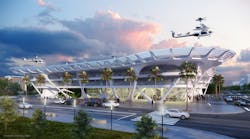Gannett Fleming Named as a Finalist in Uber Elevate Skyport Challenge
Gannett Fleming earned a coveted spot among the top finalists in the Uber Elevate Skyport Challenge and unveiled its concept at the Second Annual Uber Elevate Summit on May 9 in Los Angeles.
“Our PAW design is a fundamental component of the transportation evolution envisioned by Uber Elevate,” said Ted Osborne, PP, AIA, principal architect at Gannett Fleming. “While Uber’s eVTOL will transform the notions of passenger movement, our SKYPORT, which builds upon the PAW’s modular configuration, provides the integral connection between passengers and the urban mobility of tomorrow.”
The PAW design took its inspiration from nature and integrates seamlessly with existing infrastructure — such as office buildings and parking facilities — to create intermodal transportation hubs that will help reshape our urban environments to be cleaner, safer, smarter, and less congested. The PAW:
- Features a scalable design for a single, double, triple, or quad configuration to meet transportation demands, site requirements, and FAA clearance regulations
- Is optimized for vertical takeoff and landing, charging, and passenger loading
- Has a through-put capacity of 52 eVTOLS per hour, which is enhanced by a wire guided robot that captures the front landing gear of the eVTOL, lifts the gear inches off the tarmac, and rotates the vehicle 180 degrees to position it to taxi for immediate take-off.
The zenith of the concept is SKYPORT by Gannett Fleming, a free-standing transportation hub that supports a quad PAW configuration to accommodate 208 vehicles per hour, all within a footprint of less than the 1.3 acres. By 2028, SKYPORT by Gannett Fleming will be able to scale to process 600 arrivals or departures per hour, moving 4,000 people every 60 minutes. The four-level structure:
- Offers a transition point with ground-based public transportation as well as retail and restaurant amenities
- Features intuitive wayfinding capabilities, including wall-mounted video screens, kiosks, color-coded elevators and signage, as well as an interactive connectivity with an Uber app on hand-held devices
- Uses illuminated walkways that lead passengers quickly and safely to the appropriate eVTOL
- Includes sustainability features such as photovoltaic receptors and transparent concrete to enable solar recharging as well as sound walls with acoustic baffles to let the wind pass through and minimize noise impacts
- Provides a storage and recharging site for Uber’s autonomous vehicles and eVTOLs.
“Innovation, quality, and safety are embedded in Gannett Fleming’s DNA, and we are passionate about solving the complex infrastructure challenges that face our communities,” said Bob Scaer, PE, Gannett Fleming chairman and CEO. “There are significant forces of change that are fundamentally altering the way we live, work, and relate to one another. Employees from across our company‘s many disciplines embraced the opportunity to participate in Uber's Skyport Challenge because we are committed to improving the quality of life for the communities we serve.”
The PAW and SKYPORT designs offer practical solutions to make our communities more livable, workable, accessible, and sustainable.
“This is the culmination of hundreds of designers and engineers who have created dozens of designs for a highly efficient and modular Skyport. While uberAIR might feel like a faraway dream, it’s closer than you think and urban infrastructure has to start to evolve now to keep up. We’re excited to have collaborated with leading firms to imagine how physical Skyports would work at scale and how we can best design spaces that are quiet, environmentally conscious and create natural pockets of activity for the transportation of the future,” said John Badalamenti, Uber’s head of design for Advanced Programs and Aviation.




